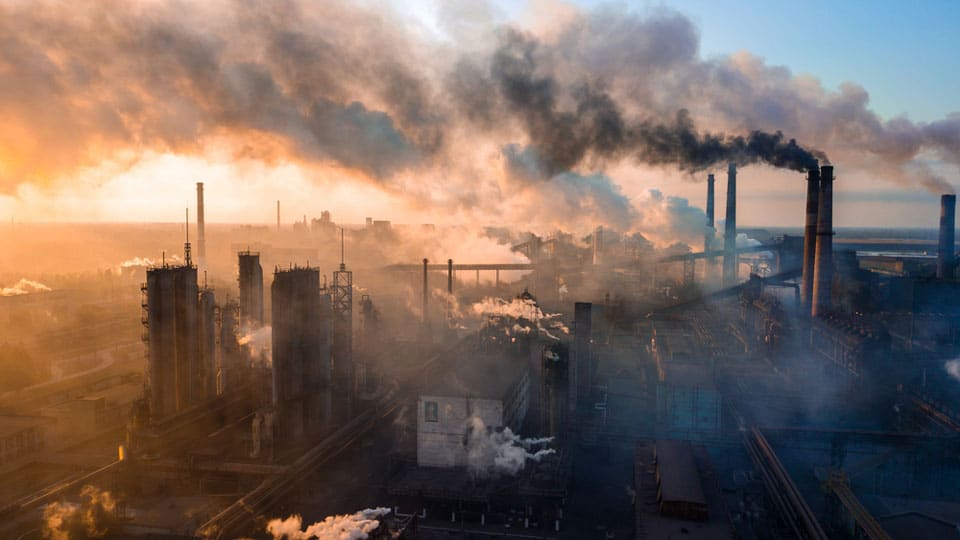Ranked: Countries That Produce the Most Carbon Dioxide (CO2), 2023

Carbon dioxide (CO2), a colorless and odorless greenhouse gas, plays a crucial role in supporting life on Earth. However, excessive concentrations of CO2 in the atmosphere can disrupt natural temperature patterns and contribute to global warming. Recent years have witnessed a significant surge in CO2 emissions, driven by various factors, including industrialization, agriculture, and deforestation. Despite a temporary decline in fossil fuel emissions during the pandemic, CO2 levels reached a record high in August 2023, prompting urgent action to address the issue.
Identifying the Top Carbon Emission Producers
A comprehensive evaluation was conducted to rank the top 25 countries producing the most carbon dioxide emissions. Three primary metrics were considered: CO2 emissions per capita, total carbon emissions, and CO2 emissions per GDP. Each metric was weighted differently, with CO2 emissions per capita receiving the highest weight.
Top 25 Countries That Produce the Most Carbon Dioxide (CO2), 2023
- Saudi Arabia
CO2 Emissions per Capita: 14.3 metric tons
Total Carbon Emissions: 672.38
Pledged not to build new power plants without carbon capture technology and allocated over $266 billion for cleaner electricity production and grid expansion.
Launched the Saudi Green Initiative, aiming to reduce CO2 emissions by 60% across the region, equivalent to 130 million tons. - Kuwait
CO2 Emissions per Capita: 21.2 metric tons
Total Carbon Emissions: 106.15
High electricity demand and reliance on the oil sector drive emissions, exacerbating the issue of carbon emissions - Bahrain
CO2 Emissions per Capita: 22 metric tons
Total Carbon Emissions: 39.02
Targeting net-zero carbon emissions by 2060, implementing strategies like carbon capture technology and afforestation. - Qatar
CO2 Emissions per Capita: 31.7 metric tons
Total Carbon Emissions: 95.67
Analyzing the impact of the FIFA World Cup revealed that travel and accommodation contributed to 95% of greenhouse gas emissions. - United Arab Emirates
CO2 Emissions per Capita: 20.3 metric tons
Total Carbon Emissions: 204.08
High energy production and consumption drive emissions; aims to achieve net-zero carbon emissions by 2050. - Russia
CO2 Emissions per Capita: 11.2 metric tons
Total Carbon Emissions: 1755.53
Energy sector is the key contributor to carbon emissions; Russia aims to reduce emissions to 70% of 1990 levels in the next decade as per the Paris Agreement. - Oman
CO2 Emissions per Capita: 15.6 metric tons
Total Carbon Emissions: 80.97
Industrial sector, including cement, ammonia, and petrochemicals, is the primary source of CO2 emissions, followed by the oil and gas sector. - Kazakhstan
CO2 Emissions per Capita: 11.3 metric tons
Total Carbon Emissions: 276.67
Highly reliant on fossil fuels for revenue and daily use, particularly coal for power and heating, posing challenges in emission reduction. - United States
CO2 Emissions per Capita: 13 metric tons
Total Carbon Emissions: 5007.33
Experienced a 5.2% surge in carbon dioxide emissions from 2020 to 2021, emphasizing the need for aggressive emission-cutting measures. - Australia
CO2 Emissions per Capita: 14.8 metric tons
Total Carbon Emissions: 391.21
Reported a slight 0.1% increase in quarterly CO2 emissions in 2023, prompting attention to ongoing emissions reduction strategies. - Brunei
CO2 Emissions per Capita: 21.7 metric tons
Total Carbon Emissions: 10.48
Committing to a 20% reduction in carbon emissions, with plans for carbon reporting and pricing in the energy sector. - Canada
CO2 Emissions per Capita: 13.6 metric tons
Total Carbon Emissions: 545.64
Despite being a significant emitter, Canada achieved a 17.2% decrease in per capita emissions since 2005. - South Korea
CO2 Emissions per Capita: 11 metric tons
Total Carbon Emissions: 616.06
Population growth and industrialization contribute to increased emissions and pollution. - China
CO2 Emissions per Capita: 7.8 metric tons
Total Carbon Emissions: 11472.39
A large population and reliance on coal drive high energy consumption and carbon emissions. - Japan
CO2 Emissions per Capita: 8 metric tons
Total Carbon Emissions: 1067.4
Urban areas contribute significantly to emissions, with a focus on residential, transportation, and power sources. - Trinidad and Tobago
CO2 Emissions per Capita: 10.2 metric tons
Total Carbon Emissions: 36.13
High per capita emissions, but contributes only 1% to global carbon dioxide emissions. - Malaysia
CO2 Emissions per Capita: 7.4 metric tons
Total Carbon Emissions: 256.04
Targeting a 45% reduction in greenhouse gas emissions by 2030, as emissions are projected to rise significantly. - Turkmenistan
CO2 Emissions per Capita: 10.2 metric tons
Total Carbon Emissions: 82.99
Aiming for carbon neutrality by 2050 to combat climate change and its associated impacts. - Czech Republic
CO2 Emissions per Capita: 8.3 metric tons
Total Carbon Emissions: 97.3
Demonstrating progress toward UN Sustainable Development Goals, but facing challenges with increasing carbon emissions. - Palau
CO2 Emissions per Capita: 8.8 metric tons
Total Carbon Emissions: Not specified
Notable emissions due to tourism and food imports prompted a focus on reducing fossil fuel consumption. - Luxembourg
CO2 Emissions per Capita: 12.5 metric tons
Total Carbon Emissions: 8.35
High reliance on fuel burning due to its transit status and energy imports, contributing to increased CO2 emissions. - Poland
CO2 Emissions per Capita: 7.4 metric tons
Total Carbon Emissions: 328.59
Witnessed a 2.7% increase in greenhouse gas emissions in 2021, with the energy sector being the largest contributor. - Netherlands
CO2 Emissions per Capita: 7.5 metric tons
Total Carbon Emissions: 141.03
Commits to sustainable soil management and carbon storage, with recent approval for a significant carbon reduction project. - Belgium
CO2 Emissions per Capita: 7.4 metric tons
Total Carbon Emissions: 95.74
Launched “Project Greensand” to store CO2 underground in the North Sea, a promising initiative for emission control. - Singapore
CO2 Emissions per Capita: 7.7 metric tons
Total Carbon Emissions: 32.5
Pledged a 35% reduction in carbon emissions by 2030, aligning with the Paris Agreement.
Assessing global carbon emissions reveals a complex issue driven by diverse factors, from energy production to industrial activities. Countries atop this list confront environmental and economic imperatives to slash emissions. Many align with international agreements, like the Paris Agreement, and adopt measures such as carbon capture and green energy investments.
Nonetheless, challenges remain: high per capita emissions, industrial reliance, and economic constraints. Collaboration is imperative. In an interconnected world, international cooperation and shared innovations are vital to combat climate change and secure a sustainable future.
Have you read?
Largest Hotel Chains in the World.
Best Residence by Investment Programs.
International Financial Centres Ranking.
Best Citizenship by Investment (CBI).
Most Valuable Unicorns in The World.
Add CEOWORLD magazine to your Google News feed.
Follow CEOWORLD magazine headlines on: Google News, LinkedIn, Twitter, and Facebook.
Copyright 2024 The CEOWORLD magazine. All rights reserved. This material (and any extract from it) must not be copied, redistributed or placed on any website, without CEOWORLD magazine' prior written consent. For media queries, please contact: info@ceoworld.biz








